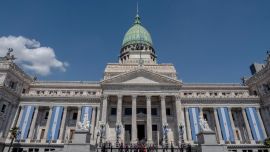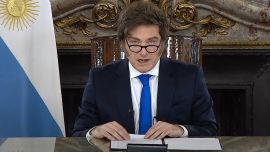A midweek press time made it impossible to have a complete overview of the alliances for the October 26 national midterms in today’s column (the deadline was the midnight of the day before yesterday) although there was already confirmation of one important definition – the La Libertad Avanza far right and the PRO centre-right extending their Buenos Aires Province alliance to this city although its label was not available to this space at time of writing. The final libertarian offer was generous by the standards of presidential chief-of-staff Karina Milei, allowing PRO to keep two of its three outgoing deputies (out of seven Juntos por el Cambio legislators because previous City Mayor Horacio Rodríguez Larreta was extremely indulgent with his allies) but absent from the senatorial duo – there is still a week to decide if the two names are closer to Security Minister Patricia Bullrich (who jumped ship from PRO only three months ago) or the Macri cousins (ex-president Mauricio and Mayor Jorge) with the only certainty being that former Buenos Aires Province PRO governor María Eugenia Vidal will not be returning to Congress.
This arrangement ignores the logic of last Saturday’s column which cited the precedent of the 2013 senatorial race to argue that this City’s anti-Peronist traditions are strong enough to present two non-Kirchnerite options (back then PRO and the UNEN centre-left) and clinch both the two senators for the winners and the minority senator for the runners-up at Peronist expense – this time around there was potential to repeat this formula with both La Libertad Avanza and the four Juntos por el Cambio fragments topping 30 percent (no less than 43 percent of voters shunned the polarisation between President Javier Milei and Kirchnerism). Instead the government prefers to gun for an impressively massive win while leaving incumbent La Cámpora Senator Mariano Recalde (assuming he is nominated) safe in his seat.
Unable to analyse the alliances beyond this city until next week, today’s column will instead focus on a recent electoral phenomenon outside its boundaries – the “Grito Federal (federal scream)” front formed on July 30 by five provincial governors to pool their forces nationwide with an electoral proposal at odds with both President Milei and Kirchnerism. This quintet includes the two largest and most industrialised inland provinces – Córdoba and Santa Fe, respectively governed by the Peronist Martín Llaryora and the Radical Maximiliano Pullaro – although Chubut’s young PRO Governor Ignacio Torres was both the host and spokesman of the first meeting. Claudio Vidal (Santa Cruz) and Radical Carlos Sadir (Jujuy) completed the group. All three of the smaller provinces are rich in mineral resources.
What is the scope for these five governors being joined by one or all of the other 18? In some senses all of them since the submission of both ATN Treasury assistance and fuel taxation to federal revenue-sharing is demanded unanimously – it would also be hard to find a governor in agreement with suspending public works at the expense of infrastructure even if it gives Milei his precious fiscal surplus. But if Juan Domingo Perón liked to say: “When I define, I exclude,” as soon as the five governors start defining their electoral proposal, they will exclude – if that proposal confronts both Milei and Kirchnerism, as they say, the latter would bar them from another quintet (BA, Formosa, La Rioja, La Pampa and Tierra del Fuego with Santiago del Estero also nominally belonging to this group although its ex-Radical governor Gerardo Zamora is notoriously opportunistic). No province is explicitly libertarian but another half dozen might hesitate to join even a moderate opposition with three (Chaco, Entre Ríos and Mendoza) cosying up to the government while the Peronist governors of Catamarca, Salta and Tucumán have all made tactical alliances with the Mileis. This leaves the Grito Federal quintet with just six provinces as potential recruits – Corrientes, Misiones, Neuquén, Río Negro, San Juan and San Luis. Here Radical Corrientes and the two Sans would seem the best bets since the other three provinces are governed by parties local almost to the point of being autistic with little capacity for national projection.
Their proposal has yet to take shape but the main thrust of these five provinces rich in grain, oil and lithium is to defend an inland productive sector whose development is fettered by both Milei´s fiscal surplus denying infrastructure and a Kirchnerite populism steering distribution towards Greater Buenos Aires. But in many ways the Grito Federal group is looking like a defensive alliance of governors from different parties with few common denominators to advance definitions. Rather than harbouring great expectations of midterms looming only a dozen weeks after foundation of their grouping, they are looking ahead in the long term to the general elections of 2027 to see how much they can expand on the 6.73 percent garnered in 2023 by previous Córdoba governor Juan Schiaretti, a prime architect of the new group.
In looking at the prospects, it is important to distinguish between the middle ground or third way and federalism, which are not the same thing. The governors are in many ways stepping into the leadership vacuums of all three previous ruling parties (the Peronists, PRO and the Radicals) and the implosion of Juntos por el Cambio. The hard cores of the libertarians and Kirchnerites accounting for around a third and quarter of the votes respectively would seem to leave a bulky percentage for the middle ground but there is always the danger of those disenchanted between the polarisation not voting at all although Grito Federal could provide an outlet for those disappointed with Milei.
As for federalism, an analysis of its prospects had best await knowledge of how the local alliances fell into place across the country so it makes more sense to look at its current structures in Congress. Some 30 of the 257 deputies are clearly identified with federalism or their home province. Half of these are in the Encuentro Federal caucus headed by Mauricio Macri’s 2019 running-mate Miguel Angel Pichetto while eight deputies from Misiones, Río Negro and Salta are grouped in Innovación Federal. Three Santa Fe deputies elected for major parties have gone local, San Juan and Santa Cruz have two deputies each outside the national caucuses while the Patagonian provinces of Neuquén and Tierra del Fuego each have their own deputy. There is little interface between these sitting deputies and the new group with scant inclination to place any October entries under Pichetto’s leadership.
Next week fuller information on the national alliances across the country.



















Comments